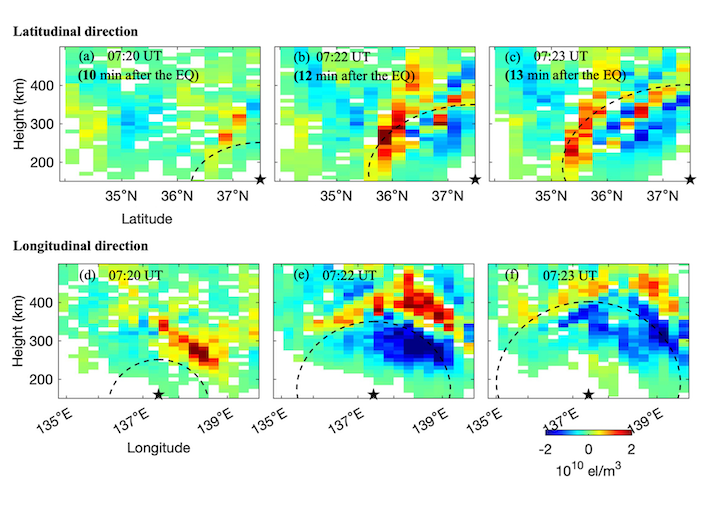A joint research team from Nagoya University Institute for Space-Earth Environmental Research, the University of Oslo Faculty of Mathematics and Natural Sciences, Kyoto University Institute for Integrated Cell-Material Sciences, and the National Institute of Information and Communications Technology conducted ionospheric tomography analysis using data from Japan's ultra-dense GNSS observation network. They clarified, for the first time, the 3D characteristics of ionospheric electron density fluctuations, spatially and temporally evolving, immediately following the Noto Peninsula Earthquake of 2024.
High-Precision 3D Visualization of Ionospheric Variations After Earthquakes
June 6, 2025
Background
With the proliferation of GNSS receiver networks, it has become possible to capture ionospheric variations near 300 km altitude in two-dimensional horizontal maps. In recent years, the impact of earthquakes, volcanoes, and weather phenomena on the ionosphere has been revealed (※1, ※2, ※3). However, conventional observation techniques using these 2D maps have not been able to provide vertical direction information of the ionosphere. As a result, there have been limitations in understanding the three-dimensional structure and the development process of disturbances in detail.
Details
The joint research team successfully applied their newly developed 3D ionospheric tomography technique to the data from approximately 1,300 stations of the Geospatial Information Authority of Japan’s GEONET and more than 3,300 GNSS receivers from SoftBank Corp. (※4). This technique revealed the three-dimensional structure of ionospheric disturbances and their time evolution (four-dimensional change), which could not be captured by previous observations. Using this technology, they analyzed data immediately following the Noto Peninsula Earthquake that occurred on January 1, 2024. They successfully confirmed the three-dimensional wavefront of the ionospheric plasma centered around the epicenter and clarified its temporal changes.

Results of ionospheric tomography 10 minutes, 12 minutes, and 13 minutes after the 2024 Noto Peninsula Earthquake. (a)-(c) are cross-sections in the latitudinal direction including the earthquake epicenter, and (d)-(f) are cross-sections in the longitudinal direction. The colors represent plasma density in the ionosphere.
Importance of the Results
This study is important since it captured three-dimensional variations in the ionosphere caused by an earthquake and clarified in detail the formation and development of those changes. This method is expected to not only promote understanding of the interaction between earthquakes and the space environment but also enable more precise ionospheric monitoring.
Notes
※1: Ripple-like waves observed at 300 km altitude after the 2011 Tohoku Earthquake
https://www.nict.go.jp/press/2011/11/111104-02.html
https://www.nict.go.jp/press/2011/11/111104-02.html
※2: Power of massive cumulonimbus clouds that cause tornadoes, reaching into space
https://www.nict.go.jp/press/2013/11/01-1.html
https://www.nict.go.jp/press/2013/11/01-1.html
※3: Ionospheric hole caused by the Tonga undersea volcanic eruption
https://www.nict.go.jp/press/2023/05/22-1.html
https://www.nict.go.jp/press/2023/05/22-1.html
※4: Data provided by SoftBank Corp. and ALES Corp. through the framework of the "Consortium for Space and Earth Science Utilization of SoftBank's Proprietary Reference Point Data"
Paper Information
- Journal:
- Earth, Planets and Space
- Title:
- Unveiling the Vertical Ionospheric Responses Following the 2024 Noto Peninsula Earthquake with an Ultra-Dense GNSS Network
- Authors:
- Weizheng Fu (Institute for Space–Earth Environmental Research, Nagoya University), Yuichi Otsuka (Institute for Space–Earth Environmental Research, Nagoya University), Nicholas Ssessanga (Department of Physics, University of Oslo), Atsuki Shinbori (Institute for Space–Earth Environmental Research, Nagoya University), Takuya Sori (Research Institute for Sustainable Humanosphere, Kyoto University), Michi Nishioka (National Institute of Information and Communications Technology, NICT), Septi Perwitasari (National Institute of Information and Communications Technology, NICT)
- DOI:
- https://doi.org/10.1186/s40623-025-02211-y
Related Announcement
- Nagoya University Research Results Announcement Site
Japanese version:
https://www.nagoya-u.ac.jp/researchinfo/result/2025/05/3-3.html
English version:
https://www.nagoya-u.ac.jp/researchinfo/result-en/2025/05/20250529-01.html
Contact
Michi Nishioka
Septi Perwitasari
Space Environment Laboratory
Radio Propagation Research Center
Radio Research Institute
E-mail: nishioka nict.go.jp
nict.go.jp
 nict.go.jp
nict.go.jpE-mail: septi.perwitasari nict.go.jp
nict.go.jp
 nict.go.jp
nict.go.jp